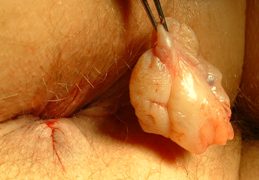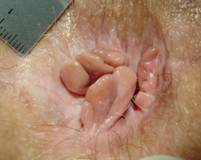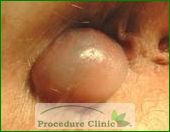Hemorrhoids Online Registration
Uncomplicated External Hemorrhoids

External hemorrhoids are prone to intermittent flare-ups and can become large or persistent enough that they require surgical excision (external hemorrhoidectomy). Small and asymptomatic external hemorrhoids, however, don’t usually need any treatment.
Anal Tags
 Anal tags are excess, flesh-colored skin folds that appear around the anal opening, attached via a stalk or stem that supplies blood to the tag. Anal tags can be associated with a variety of anorectal issues and can cause discomfort, itching and discharge.
Anal tags are excess, flesh-colored skin folds that appear around the anal opening, attached via a stalk or stem that supplies blood to the tag. Anal tags can be associated with a variety of anorectal issues and can cause discomfort, itching and discharge.
Causes of anal tags include:
While anal tags can be very irritating, they can easily be removed with a simple radio frequency device. This 10-minute procedure is performed in an office using local anesthesia and requires zero downtime.
Thrombosed External Hemorrhoids
An external hemorrhoid can escalate to a thrombosed external hemorrhoid due to varicose veins rupturing causing blood clots to form in the anal tissue. Thrombosed external hemorrhoids are associated with swelling, a bluish-purplish discoloration, and severe pain.
Treatment Options
 A simple treatment method for less severe external hemorrhoids is to allow the hemorrhoidal blood clots to slowly absorb into the body over several weeks. This approach is successful when paired with home remedies such as sitz baths, stool softeners, and increased fiber and fluid intake.
A simple treatment method for less severe external hemorrhoids is to allow the hemorrhoidal blood clots to slowly absorb into the body over several weeks. This approach is successful when paired with home remedies such as sitz baths, stool softeners, and increased fiber and fluid intake.
For more severe cases, surgical excision is often more effective and efficient, especially for patients with thrombosed external hemorrhoids. Performed under local anesthesia, surgical excision is a safe, office-based procedure with low complication rates and high levels of patient satisfaction.
Surgery Procedure
There are two primary surgical methods that can be used. The first method is quicker and seemingly more efficient. Your doctor will create a small incision over the clot and squeeze out the clot’s contents. However, this method could result in blood clot recurrence and continued pain, which often requires patients to come back to the office for further treatment.
The more extensive procedure, called a full hemorrhoidectomy, your doctor will remove the entire clot and the hemorrhoidal blood vessels. This method takes longer and may require stitches, but it can yield better long-term results.
Both methods are performed under local anesthesia.
Post-Operative Care
Acetaminophen or ibuprofen can be taken for pain. Warm sitz baths should be done three times daily, 15-30 minutes per session, while stool should be kept soft by drinking lots of water and taking stool softeners.
Complications
Common complications associated with thrombosed external hemorrhoid treatment include pain, bleeding, infection and delayed healing. Some patients may also develop an anal skin tag (see above). Extremely rare complications include anal stricture (narrowing of the anal passage) and incontinence (inability to control urination and defecation).




